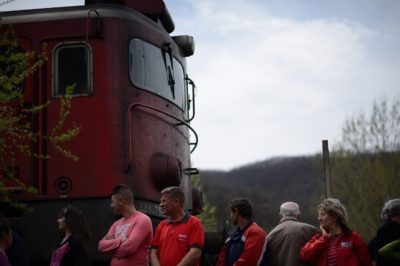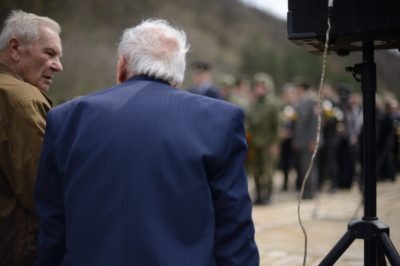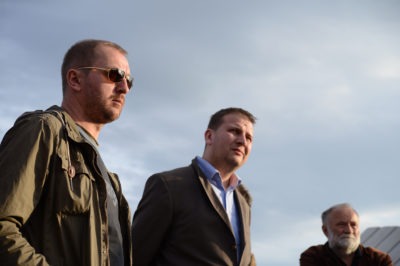Vlasotince, a town of 33.500 inhabitants, was the site of the first gathering in Serbia of war veterans from the wars of the 1990s that accompanied the disintegration of Yugoslavia. The Centre for Non-Violent Action from BiH brought the well-known group of veterans that I had already been to Berlin and Srebrenica with. Plus, there were two veterans from the Croatian Army, and the organisers, Novica and Goran.

It’s interesting how much one’s view of the landscape depends on the season. The first time I travelled through Serbia, from Užice towards the south, it was October. Most sights seemed to suggest neglect and gloom. Now, it was spring and we were taking the same route, except that instead of going to Sofia, our destination was Vlasotinac, a town near Leskovac. Green was the dominant colour, and people seemed more vibrant, not a trace of gloominess. Looking at things through springtime lenses was pleasant. Vlasotince, a town of 33.500 inhabitants, was the site of the first gathering in Serbia of war veterans from the wars of the 1990s that accompanied the disintegration of Yugoslavia. The Centre for Non-Violent Action from BiH brought the well-known group of veterans that I had already been to Berlin and Srebrenica with. Plus two veterans of the Croatian Army, and the organisers, Novica and Goran, from Vlasotince, long-time members of the CNA team. For the first time, our group met with veterans from Vlasotince, Niš, Leskovac, Pirot, Prokuplje and Kruševac. At the beginning, there was anxiety and tension because the situation was something new for everyone, and then with food and drink, everything seemed to relax.
The central event was the commemoration of innocent civilian victims killed at Grdelička gorge when NATO planes bombed train No. 393 commuting from Belgrade to Thessaloniki, killing 15 passengers whose identity is known, while another fifty passengers are treated as missing. Our host Novica Kostić was an eyewitness to this event that falls within the category of “collateral damage”. He told me there had been pieces of charred human flesh strewn about everywhere, he used a rustic comparison, visual and surreal. The memorial is located just beneath the railway bank before the bridge where the train was hit. The river Južna Morava flows under the bridge. To the right of the memorial is a concrete bunker from World War 2 and a patch of stubbly ground where an honorary guard stood in camouflage uniforms and with Zastava automatic rifles in their hands.

The plateau in front of the memorial is made of railway ties laid upon sand from the riverbed. The memorial is made of stone and bears the inscription: “Fear not the people themselves, but the inhuman within them…” The upper half of the monument is a cross, while at the very top is a metal part of the railway coach, the link used to connect railway vehicles. Numerous speakers take their turn, from those with a sense of measure to those portraying this as an unprecedented crime in human history. At the exact time when the train was hit, a set of two or three railway vehicles appeared, and with a long whistle from the locomotive, it stopped right next to the memorial. A delegation of veterans from the Centre for Non-Violent Action was there among the numerous delegations that had come to lay wreaths at the foot of the memorial. There were so many wreaths, people had to stand in line to honour the victims. The hostess announced each delegation as it went up to the memorial. Among the multitude, I remember the people from the ultra-right Dveri and the Serbian Radical Party. Unfortunately, commemorations often have little to do with the victims they honour. Our veterans looked and acted as befits such a moment. At one point, the honour guard fired three salvoes into the sky. Then the army got on a bus and disappeared down the dusty road. We followed suit and went to Leskovac where we were to meet with the town’s officials.
At the meeting, Yugo-nostalgia was as always the connective tissue in the conversation. It seemed like everyone in the room starts remembering their time serving the JNA. There was also mention of volunteering for state-run construction efforts and of the camaraderie among people who disappeared in the whirlwinds of war in the 1990s. Severed ties and long-ago friendships. The room exuded nostalgia for the times of Tito’s Yugoslavia.

Still, the 1990s, that all-powerful eraser that can wipe away anyone’s private history, were so intensive and destructive that the memories seemed like washed out pictures of obliterated lives. The party then moved on to the Gunjetinac Motel on the periphery of Vlasotince. The desire of Serbian war veterans to socialise with veterans from BiH and Croatia was palpable. The differences between them equally evident. While veterans from BiH and Croatia get some satisfaction out of the fact that they are recognised by their state or entity, that they receive benefits, even if they are merely symbolic, the situation in Serbia is quite different. Many said that the figure of 800.000 veterans in Serbia is exaggerated, but that there are certainly a few hundred thousand people denied status or recognition by the state for the simple reason that Serbia refuses to acknowledge its participation in the wars in Croatia and BiH, because this would constitute admission to having committed aggression against these two countries. You can then imagine hundreds of thousands of people, wounded physically and psychologically, walking idle through a country in transition. People who were not told what to do with their wartime experiences, their traumas, where to deposit them, how to process them. The massacre that took place in Velika Ivanča near Belgrade, where a war veteran killed 13 people, including a two-year-old child, is then perhaps not such an unexpected aberration. According to the laws of thermodynamics energy can never disappear. And neither can trauma. Whenever it is repressed, suppressed or negated, we can expect to see it erupt. The wars are over and one-time warrior are cast onto the garbage heap of everyday life. Look at the local crime news. They chronicle the invisible history of general disintegration brought on by the wars and the breakdown of an idea, a system, a common state. There is no species of animal more expendable than man, a fact that seems to still elude only the common man, the main ingredient of cannon fodder.
Faruk Šehić
the article published in bh magazine “Dani” 19th of April 2013